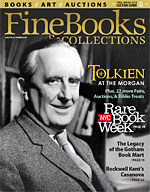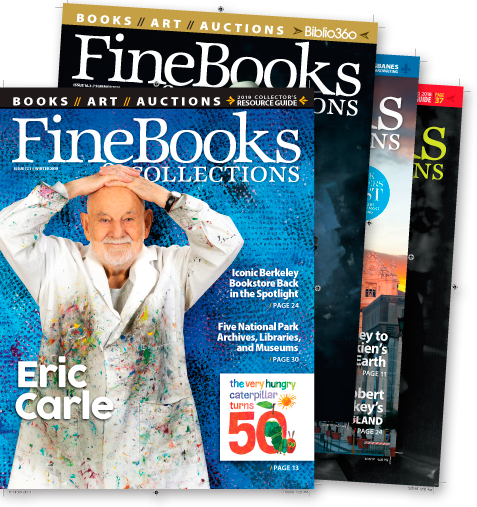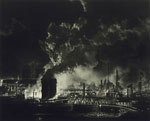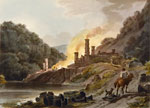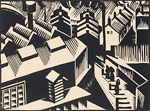A World Gone Missing
John Eckblad’s Collection of Industrial Landscapes By F. S. Naiden
In 1974, when John Eckblad began to collect prints about mines and factories, deindustrialization was only beginning. It did not occur to him that he was collecting memories. Today, as his considerable collection of prints about coal and ironworks is starting to appear in museums, even the memories are gone. One of Eckblad’s favorite prints, a color monotype showing the abandoned steel works at Mondeville in Normandy, France, could be a view of another planet: Who ever could have worked here? A ghost economy is scarier than a ghost town.
The Mondeville works shut down about 15 years ago. But a mezzotint showing the still-active U.S. steelworks in Clairton, Pennsylvania, reminds us what such places can be. The nocturnal fire bespeaks a Romantic fascination for a time when a visitor to a steel or iron mill might think of the workers not as ghosts, but as demons. (One thinks of the menacing black-faced miners of D. H. Lawrence’s Women in Love.) This Romantic attitude towards manual labor led Robert Burns to scrawl the following verses on the sooty window pane of a mill in Scotland:
We cam na here to view your works
In hopes to be mair wise,
But only, lest we gang to Hell,
It may be nae surprise.
Burns claimed he tried to enter the mill, but Hell would not have him:
But when we tirl'd at your door,
Your porter dought na hear us;
Sae may, should we to Hell's yetts come,
Your billy Satan sair us.
These much-quoted verses are misleading. The hell of industry was not a place with no public entrance. A clerk at the mill—he liked his job, and later would own a share of the mill—penned this response to Burns in an order book:
If you came here to view our works
You should have been more civil
Six days a week to you and all,
We think it very well;
The other, if you go to church,
May keep you out of hell.
These are the three ways to follow Eckblad’s example and collect industrial prints. Take (or learn about) the viewpoint of the spectator, who may be an artist. Or take the viewpoint of the owner, who often commissions the artist. Or take the viewpoint of the devil. He’s the worker. The spectator and the owner know commendably little about him.
Like the images of Mondeville and Clairton, much of Eckblad’s collection takes the viewpoint of the spectator and artist. The reason may be Eckblad’s childhood move from rural Minnesota to the Pittsburgh area, then the center of the U.S. steel industry. In college Eckblad drove an ice-cream truck on a route around the Duquesne works, parking for half an hour to watch the flare stacks while hoping the ice cream didn’t melt. Although he spent most of his career in Europe, his early perspective stayed with him through his work as a mediator specializing in labor relations at mines and factories in Britain and on the Continent. A stint in France, where Eckblad set up the first French MBA program at one of the grandes ecoles that dominate the French university system, accounts for the many French prints in his collection. Yet the main reason for the collection is Eckblad’s eye for the visual impact of the great workplaces of the industrial era—for the amazement expressed in early 19th-century images, like one from a series entitled The Romantic and Picturesque Scenery of England and Wales. Back then, an iron works could be picturesque, even a tourist attraction.
And Eckblad has a penchant for artists who draw industrial sites according to an esthetic program. Yorkshire, a 1920 woodcut by the English Futurist Edward Wadsworth, turns an industrial townscape in the north of England into an experiment of perversely reinforcing patterns of distortion and regularization. The range of effects in these diverse prints is as great as the sweep of centuries and locales being represented. For the collector, these effects have been formative. He says, “I’m no longer building my collection, my collection is building me.”
One of the rewards of collecting prints is the interplay of lithography, painting, and photography. Until around 1850, prints were documentary and appeared mainly in books. They were too expensive for most magazines and were less prestigious than paintings. After 1850, lithography and photography took over as documents. Prints became cheaper. Although they were a popular, not a cultivated, form, in the hands of artists like Wadsworth they could be experimental. Yet they were subject to commercial pressures in a way modern painting almost never was. Eckblad tells of how, in 1939, the English artist Jackson Lee Nesbitt was forced by Sheffield Steel to redraw his etching, Stripping Ingots: The engineering department had approved it but the public relations department insisted that Nesbitt draw modern ingot molds rather than the outdated ones they were using.


